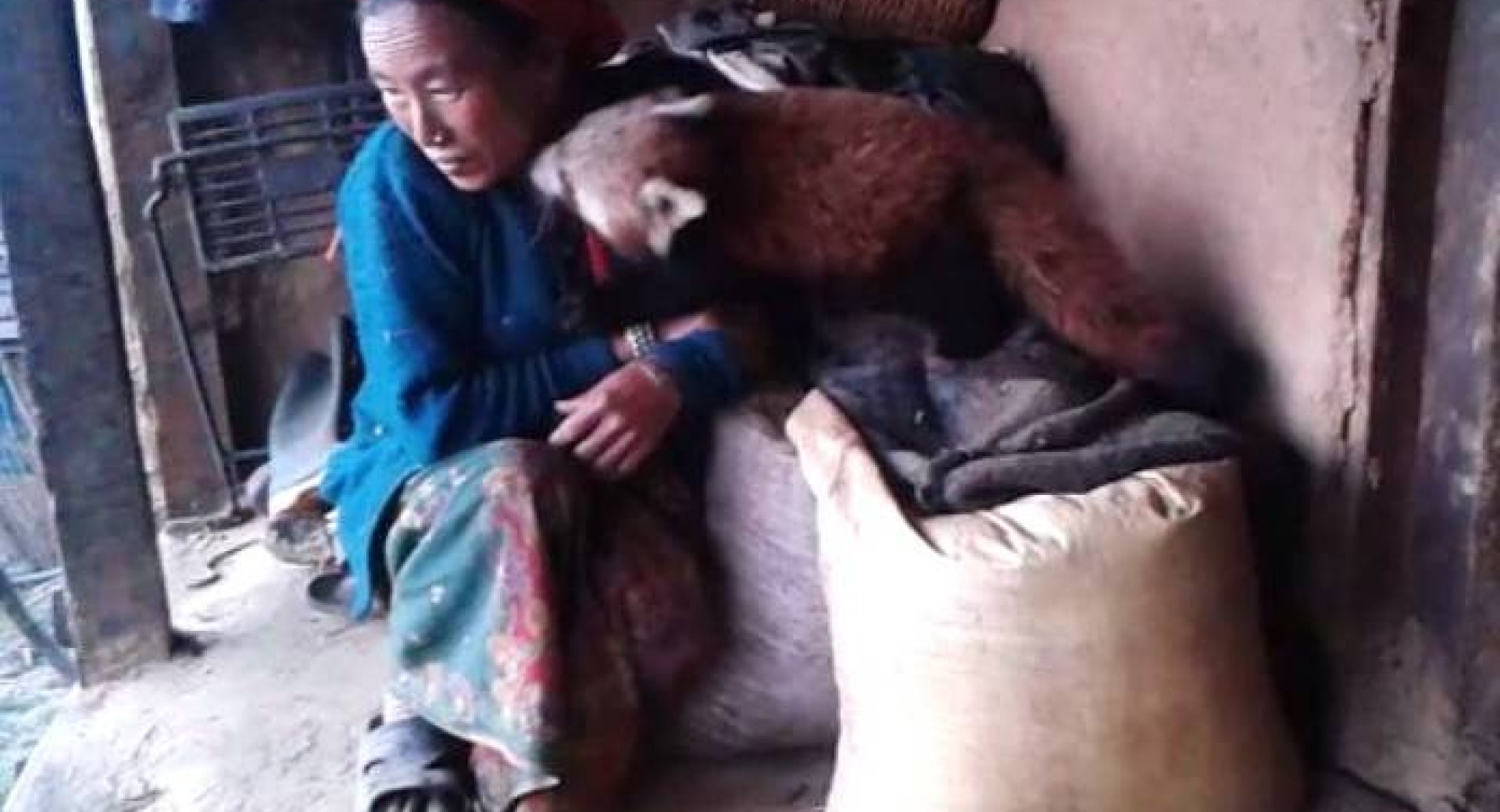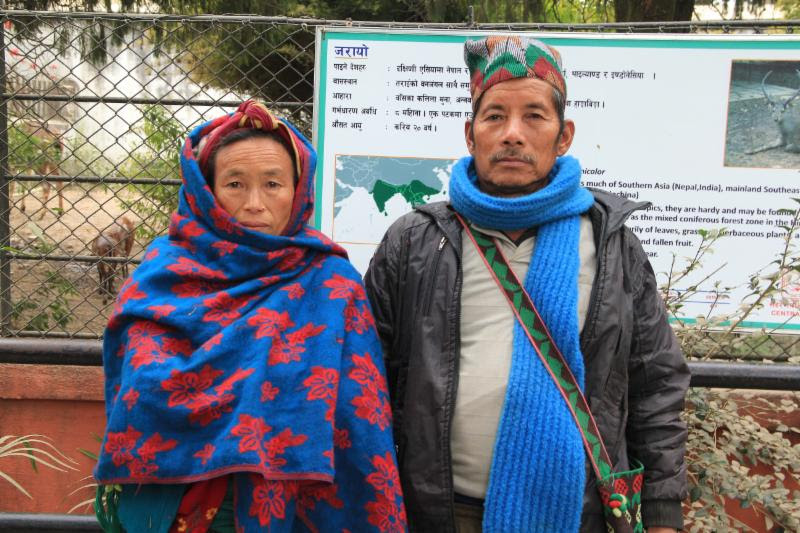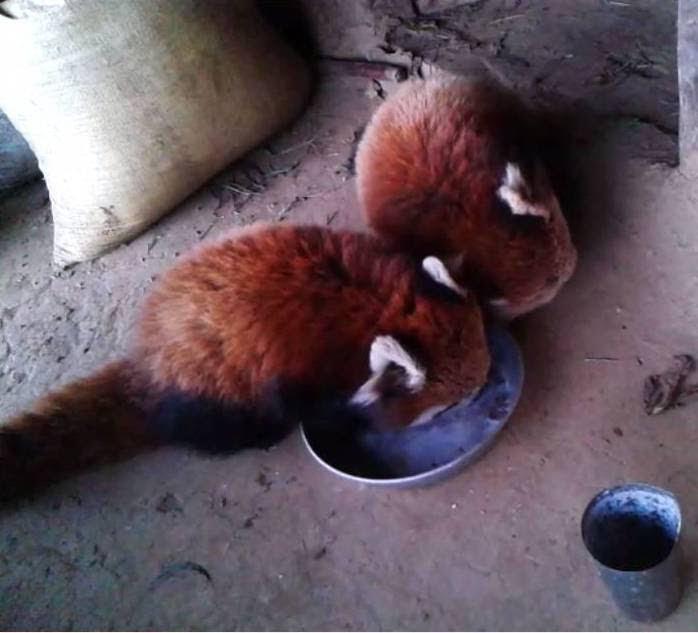
THIS IS THE TRUE STORY OF TWO ORPHANED RED PANDA CUBS RAISED BY LAHARI AND MAN BUDHAMAGAR OF ROLPA DISTRICT IN MID-WESTERN NEPAL.
Lahari Budhamagar burst into tears when she arrived at Central Zoo with the officials of District Forest Office to hand over a pair of red panda cubs which she had raised for five months in Gaam Village of Rolpa District. She was visiting Kathmandu for the first time at the age of 50. Lahari was accompanied by her husband Man Bahadur Budhamagar, 59, who found the cubs in a forest where they raise their Sampati, the word he uses for livestock. She liked the enclosure the zoo had for red pandas, but was also worried that they would not be free as in the wild and felt it was like keeping them in a jail.
 Lahari and Man Budhamagar
Lahari and Man Budhamagar
Just six months ago, when Man Bahadur went to the forest in search of wild mushrooms, he heard something tweet. The tweet almost sounded like when a person whistles. When he approached the place the tweet was coming from, he found a pair of tiny red panda cubs, white and brown in color. The cubs were the "size of baby rats" and were both on the ground and helpless. At the time he thought they were fox pups, and he brought them to his cattle herding station and kept them in his goth (small hut). Man Bahadur assumed that their mother had died, likely as prey to a natural predator of red pandas. He assumed it was a natural death, and not poaching, because the forest from where he found the cubs is located near a community where Radio Ganatantra is stationed. Radio Ganatantra is a partner of Red Panda Network and regularly airs red panda conservation programs which have helped to increase local red panda awareness and stewardship.
On the first day he brought the cubs to the goth, they survived without eating anything, as he had no idea what to feed them. On the second day, he brought them home to the village, and his wife suggested he feed them goat's milk. After trial and error, the couple taught the cubs to drink goat's and cow's milk. After three weeks the cubs were able to feed by themselves. One day, Man Bahadur thought they could eat meat, as they looked like carnivores, and fed them a small amount of meat, but it seemed they couldn't digest the meat and vomited. Later on, when Man Bahadur saw that the cubs' waste was greenish in color, he suspected they might be eating grass. When he watched them, he found out that they were eating immature leaves of barley and corn. He then started to feed them leaves of bamboo and reduced the amount of milk.
 Red panda cubs of Rolpa District.
Red panda cubs of Rolpa District.
The cubs disappeared from their home during Tihar festival, as their home was crowded with people, but they returned after two days. The news that the couple was rearing the cubs went viral, and after many people had seen and photographed them during Tihar festival, Man Bahadur came to know that the animals they were caring for were red pandas. Later on, he felt unsafe keeping them in his home, and he approached the District Forest Office (DFO) at Libang.
Mr. Hari Narayan Mandal, the District Forest Officer of Rolpa, decided to send the red pandas to the Central Zoo in Kathmandu. He felt it could be unsafe to release them into the wild after being raised by people for a long period of time. Mr. Mandal went on to say, "as we are seeing an increased frequency in live trapping and rearing of red pandas and other wild animals in Nepal, there is an urgent need for local and national Government to establish a wildlife rehabilitation center where those animals can be prepared for reintroduction into nature. When I was there in the same village for a social survey regarding red panda conservation in 2013, 98% of the people hadn't heard of red pandas, and one hundred percent of the people were unaware of the conservation value and legal status of the animal. The prevailing misconception on the use of wildlife body parts can be reduced by increasing conservation awareness. It indicates the need for massive conservation awareness outreach programs in the areas. The conservation of endangered animals also needs to be included in the agendas of political parties in Nepal." Mr. Budha Magar also wanted to meet with the Members of Parliament from Rolpa district to convey the importance of the conservation of red pandas and ask for it to be made a priority.
Sonam Tashi Lama
Program Coordinator
Red Panda Network
